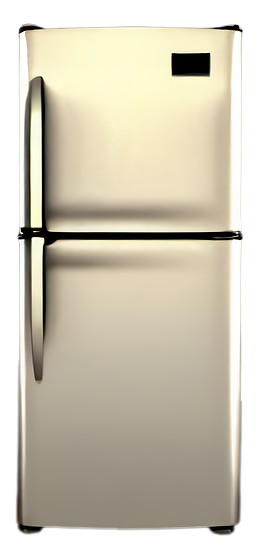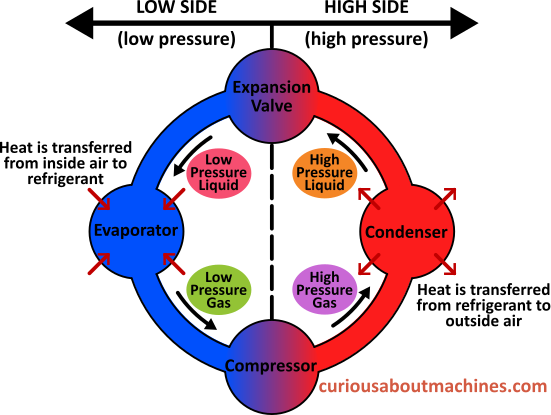By Adven Simarmata. Last updated on September 28th, 2023.
Working Principle of Refrigerators

Refrigerators are kitchen appliances that have a function of keeping the food inside fresh for a long period of time. Food preservation is a basic need in almost every household in modern civilization. This is because people’s houses are far from food sources, so they need to prolong the shelf life of their food. Food-poisoning bacteria grow best at temperatures roughly between 5 to 60 degrees Celsius, known as the temperature danger zone.[1] Refrigerators keep the food fresh by cooling the food to be lower than 5 degrees Celsius. Refrigerators maintain a cool temperature in the space inside by continuously taking heat from the inside of the refrigerator and then discharging the heat to the surrounding area through the back of the refrigerator. This is why it feels hot when we put our hands at the back of the refrigerator. How do refrigerators remove the heat from the space inside?
There is a closed circuit inside a refrigerator. A carefully chosen chemical, called the refrigerant, continuously flows around the circuit. Inside the circuit, the refrigerant alternately changes its phase from liquid to gas and from gas to liquid. The phase changes of the refrigerant are the key for the refrigerant to absorb the heat from the inside of the refrigerator and release the heat to the outside of the refrigerator, thus maintaining low temperature inside the refrigerator.
Desirable Properties of Refrigerants
The refrigerant must have a low boiling point, which means the temperature at which the refrigerant changes phase from liquid to gas (evaporates) or from gas to liquid (condensates) must be low. This is so that the refrigerant can evaporate easily when absorbing the relatively small amount of heat from the area inside the refrigerator and condense easily when releasing the heat to the surroundings. The ability of the refrigerant to change back and forth from liquid to gas and vice versa enables the refrigerator to continuously repeat the refrigeration cycle, widely known as the vapor compression cycle.
Main Components of a Refrigerator
There are four main components of refrigerator to accomplish the vapor compression cycle, as shown in Figure 2. Figure 3 shows the changes of phase between the components.

1. Compressor
The compressor is the heart of the refrigerator because it circulates the refrigerant in the circuit. The reciprocating compressor is commonly used in the domestic refrigerators. It is usually put in the back of the refrigerator, usually at the bottom. The low-pressure refrigerant in gaseous state enters the compressor. The compressor adiabatically squeezes this gas to increase its pressure, thus increasing its temperature too.
2. Condenser
The condenser is located outside the refrigerator, usually at the back of the refrigerator. The high-pressure, high-temperature gas enters the condenser coil. The reason why the condenser coil has to be wound is to increase the area of contact of the refrigerant to the air, enabling the refrigerant to release more heat. In the condenser, the gas loses heat to the surroundings and begins to condense into a liquid.
3. Expansion valve
The refrigerant that enters the expansion valve is a high-pressure liquid. The expansion valve abruptly reduces the pressure of the liquid by restricting its flow, making it expand, cool down, and turn partly into gas. This is according to Joule-Thomson effect, which is the change of temperature of a liquid from a higher-pressure region to the lower-pressure one.
4. Evaporator
The evaporator coil is fitted inside the refrigerator. It is made wound just like the condenser coil to increase the amount of heat transferred. The refrigerant that enters the evaporator is a cold, low-pressure liquid. As the liquid refrigerant passes through the evaporator, it absorbs heat from the food and air inside the refrigerator. Heat is a form of energy. Giving heat to the liquid molecules means giving more energy for the molecules to break away. Thus, the refrigerant evaporates and turns completely into a low-pressure gas. Now, the refrigerant goes back to the compressor, and the cycle is repeated.

Additional Components
The main components of the refrigerator have been discussed. Now, let’s talk about the additional components of the refrigerator that support it to work more efficiently.
1. Radiator fins
The radiator fins are put at the same location as the condenser coil, as shown in Figure 2. The radiator fins are used to help dissipate the heat from the refrigerant.
2. Thermostat
Thermostat is a regulator for automatically starting or stopping the compressor according to the temperature inside the refrigerator. If the temperature inside the refrigerator is too high, the thermostat will switch the compressor on. On the contrary, if the temperature inside the refrigerator is too low, it will switch the compressor off.
3. Control knob
The control knob is used to set the desired temperature of the refrigerator. It is connected to the thermostat.
Conclusion
Refrigerators provide cooling to the inside space by circulating refrigerant in the refrigeration circuit. In the circuit, the refrigerant alternately changes its phase from liquid to gas and vice versa. When the refrigerant changes its phase from liquid to gas (evaporates), it takes up the heat from the space inside the refrigerator. Meanwhile, when the refrigerant changes its phase from gas to liquid (condenses), it releases the heat to the surroundings.
References
- Bacteria grow in the temperature danger zone. Government of Western Australia Department of Health. (2020, October 30). Retrieved February 15, 2023, from https://ww2.health.wa.gov.au/Articles/A_E/Bacteria-grow-in-the-temperature-danger-zone

Leave a Reply